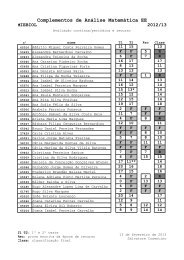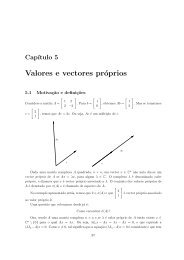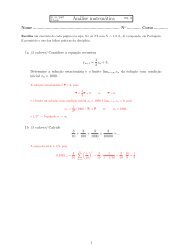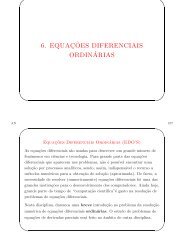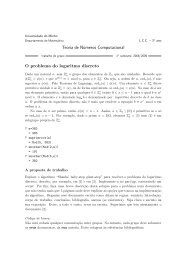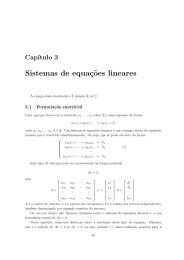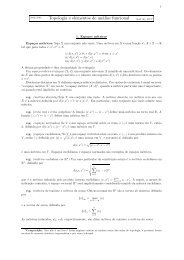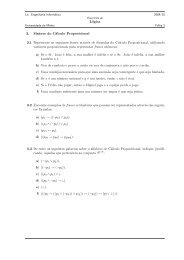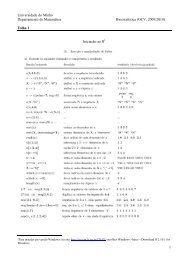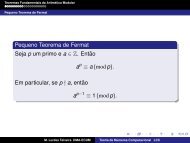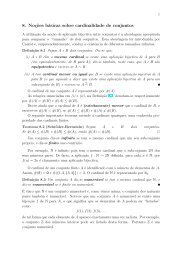My title - Departamento de Matemática da Universidade do Minho
My title - Departamento de Matemática da Universidade do Minho
My title - Departamento de Matemática da Universidade do Minho
You also want an ePaper? Increase the reach of your titles
YUMPU automatically turns print PDFs into web optimized ePapers that Google loves.
4<br />
NÚMEROS E DINÂMICA 24<br />
Exercícios.<br />
• Describe periodic and pre-preriodic points of σ : Σ + → Σ + . Show that they are <strong>de</strong>nse in Σ + .<br />
• Consi<strong>de</strong>r the alphabet A = {0, 1, 2, . . . , 9}. Define a map h : A N → [0, 1] as<br />
(x 1 , x 2 , x 3 , . . . ) ↦→ 0.x 1 x 2 x 3 . . . .<br />
Show that h is onto, and <strong>de</strong>scribe the map sending h(x) into h(σ(x)).<br />
4.3 Rotações <strong>do</strong> círculo/toro<br />
Arithmetic progressions and exponential sums.<br />
The dynamics of an arithmetic progression<br />
a a + α a + 2α a + 3α . . . a + nα . . . ,<br />
obtained from the initial condition x 0 = a using the recursion x n+1 = x n + α, is quite trivial. All<br />
trajectories x n = a + nα diverge, provi<strong>de</strong>d α ≠ 0.<br />
Nevertheless, if we average the observable ϕ(x) = e 2πix , something interesting appears: apart<br />
from a constant factor e 2πia and the normalization 1/n, the Birkhoff averages read<br />
n−1<br />
∑<br />
S α (n) = e 2πikα .<br />
n=0<br />
Sums as E(N) = ∑ n<br />
k=1 e2πix k<br />
are called exponential sums, and contain “spectral information”<br />
about the distribution of the numbers x k modulo 1. Triangular inequality gives the trivial bound<br />
|E(N)| ≤ N, i.e. E(N) = O(N). If the different exponentials e 2πix k<br />
were “uncorrelated”, as<br />
successive positions of a ran<strong>do</strong>m walk in the plane, we should expect E(N) = O( √ N). This, of<br />
course, <strong>do</strong>es not happen with “<strong>de</strong>terministic” generic sequences. The best we can hope is some<br />
bound as E(N) = o(N) (which, in our case, would mean that the Birkhoff averages ϕ n → 0).<br />
Exercícios.<br />
• Show that the sum of the first n terms of an arithmetic progression x k = a + kα is<br />
n−1<br />
∑<br />
x k = n 2 (x 0 + x n−1 ) = na +<br />
k=0<br />
n(n − 1)<br />
α<br />
2<br />
• Observe that, for q ∈ N, the complex number z = e 2πi/q is a non-trivial q-th root of unity.<br />
Hence,<br />
1 + z + z 2 + · · · + z q−1 = 0 .<br />
Deduce that if α = p/q ∈ Q with p ∈ Z, then<br />
∑q−1<br />
S α (q) = e 2πikp/q = 1<br />
so that the exponential sum S p/q (n) is periodic, and in particular is o(N).<br />
n=0<br />
O círculo. O círculo (o esfera <strong>de</strong> dimensão 1) é o espaço quociente S 1 = R/Z <strong>do</strong> grupo comutativo<br />
R pelo subgrupo Z, muni<strong>do</strong> <strong>da</strong> topologia quociente her<strong>da</strong><strong>da</strong> <strong>da</strong> topologia euclidiana <strong>da</strong> reta.<br />
A métrica euclidiana <strong>da</strong> reta induz uma métrica invariante d no círculo, <strong>de</strong>fini<strong>da</strong> por<br />
d (x + Z, x ′ + Z) = min |y − y ′ |<br />
y∈π −1 {x+Z}, y ′ ∈π −1 {x ′ +Z}<br />
on<strong>de</strong> π : R → R/Z <strong>de</strong>nota a projeção x ↦→ x + Z.<br />
= min<br />
n∈Z |x − x′ + n|



